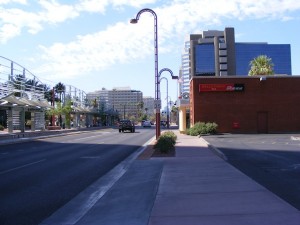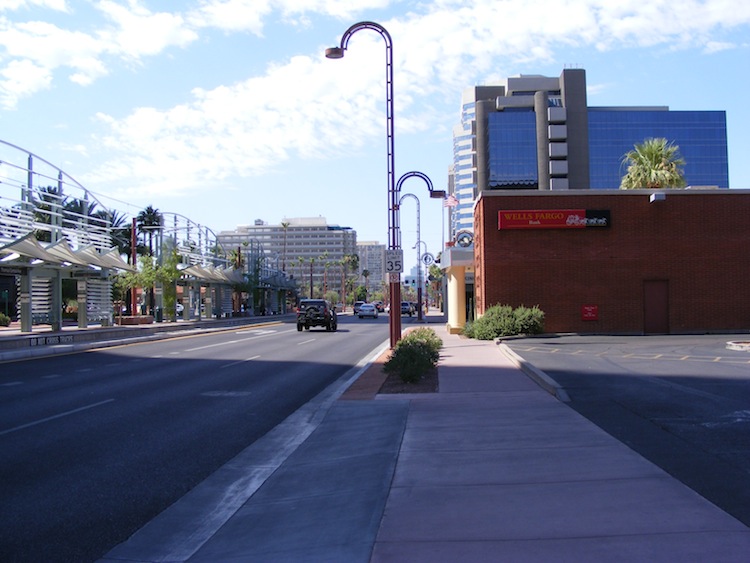 This morning, I was running some errands and had to walk between the two banks on Central, just north of Thomas, you know – the Wells Fargo and Bank of America there. It didn’t make sense to get into my car, drive for 5 seconds, park and go to the next door bank, so I walked.
This morning, I was running some errands and had to walk between the two banks on Central, just north of Thomas, you know – the Wells Fargo and Bank of America there. It didn’t make sense to get into my car, drive for 5 seconds, park and go to the next door bank, so I walked.
As I walked out onto the sidewalk (thankfully it was in the shade on this 109° summer day) I was struck by the smell of the city, the growl of the cars as they whizzed by and the sight of people waiting for the light rail. There’s something unique to the experience of walking in the city, even our city that isn’t particularly dense or active on a pedestrian level.
This morning, on my short 2 minute walk, I was reminded of the walks I’ve taken in other cities like Paris, London, Mexico City, Buenos Aires, Mumbai, Barcelona and Johannesburg. I’ve always felt a thrill walking in these great urban centers, all my senses engaged in the activity around me. There’s something very invigorating about being in the middle of the hustle and bustle of city life.
In contrast to the exciting energy of walking in the city, I noticed this morning how isolated I felt in my car. I was in the very same spot as when I was walking, but my experience of the city was completley different. In fact, I hardly experienced the city at all, other than the necessary awareness of my surroundings required to drive safely. The sounds of the city were completely silenced within my sealed, air-conditioned vehicle. I could not smell the city smells or hear the sounds of cars outside. It felt as if I were in a bubble, as if I were by myself, when in fact I was sharing the road with many other people, who I’m sure, also felt as if they were alone.
This is the kind of experiential deficit that happens in Phoenix because we are such a car-centric city. The visceral experience of walking in the city is a world that seems unavailable to us Phoenicians as we’ve become so addicted to the convenience of cars. Today, such a hot summer day, may not be the best day for a post like this. But the heat is just an excuse that we use to forgo the connective experience of city walking in order to lead convenient, easy, anonymous lives in our cars.
I had coffee with an up and coming architect named Moazam Khan of MoD Architecture and Planning at Giant today (as you can tell, it’s become a favorite afternoon coffee spot) and we talked about walkable cities and what they mean. We also talked about what an urban walking experience ISN’T. An urban walking experience ISN’T driving to Tempe Marketplace or Desert Ridge or Kierland Commons and shopping. That is a consumer experience, one designed to manipulate people into buying stuff. Although it may act as a public space, especially where there are fountains for kids to play and chairs and tables for people to relax in, these spaces are not truly public. They’re designed to gather people in order for them to shop at stores.
The urban implications of outdoor malls could fill many posts, probably a whole book, so let’s get back to the point of today’s post – the experience of walking in the city. I invite you to do three things:
1. Take note of how often you walk in the city. Is it a few times a day, a week, a month, a year or less than that?
2. If you haven’t already, try walking and spending time outside of your car in the urban core of a Valley city. You might want to wait until it cools down a bit, or try the evenings.
3. Take note of what’s missing. If there were more pedestrian-oriented shops, restaurants and amenities, would you walk more? This kind of awareness will, I hope, lead to a demand for more walkable spaces.
Let me know what you find out and we can discuss it here on the Blooming Rock blog!


















I appreciate the difference between an urban experience and a consumer experience. One aspect of Phoenix that I miss from other urban centers that I have lived in and traveled to around the world is the sense of awareness of the rhythm of a city and the energy provided to us through the land as we traverse it. I love running into well known spaces to pick up special supplies for art projects, chatting with store owners who recognize me, a cup of tea with friends spontaneously or having a piece of art that I eye daily as I walk by. I vote for more and more urban space as a means for us to generate greater connection in a city where one might go years before interacting with a neighbor as we pull into the drive and close the door to the world around us. Social isolation has been proven as a means for changing brain chemistry and creating depression. Thanks for bringing these dormant memories into my consciousness.
Siri Chand, you’re right in that the feeling that the things you so elegantly described are missing is not a conscious one. It’s more a void in our souls, our subconscious or whatever one calls it. I think the key is to bring this void into the forefront of our consciousness and somehow engage in bringing the life of a vibrant city to Phoenix.
Once I started commuting to work by bicycle in Phoenix, experiencing the rich flood of sensations available in the open air compared to the isolated experience of driving a car, I was hooked. I have grown accustomed to the desert heat, and plan to keep riding all summer. We live in a hot place, and I want to soak up all its sensations in all its seasons. I write about what I see and experience on my blog. I enjoy the solitude of my rides yet never feel alone. I also enjoy walking, and greatly appreciate that many pedestrian-friendly paths are also bike friendly.
That’s great to hear John…It’s good to see there are people like you making a point to enjoy and appreciate our climate, whether hot, wet or cool. I’ll make sure to check out your blog.
Having grown up in the Valley, and then spending my adult youth in NYC, I have spent a LOT of time thinking about this, probably more than is healthy.
I know what walkable cities are supposed to feel like and frankly, I don’t think that Phoenix is made for it except in short spurts and nodes that are only connectible by cars or public transport. I give the nodes full credit for being totally walkable. But if you’re not on or just outside a node, what to do?
I live a mile away from a light rail stop and am reluctant to take my kid on a mile-long hike to it just for the novelty of waiting 20 minutes for transport that would deliver me there 40 minutes later than if I left by car.
One thing lots of families don’t have is the luxury of time. When I was single I could sit on a NYC subway platform until kingdom come for the L-train, reading and studying up for my degree. Now I can’t afford that kind of luxury. David Carlson in Dwell mag this month was recently quoted as saying “In Europe, TIME is the big luxury.”
I grew up riding my bike to school in quiet and suburban Scottsdale, and hope that my kid will bike to his school someday, too. But we live in an urban heart, and I KNOW I never saw any NYC parents letting their kids bike alone across in traffic like Camelback Road.
Its a hard tradeoff. Its frustrating, but the moment you have kids, priorities change.
Alison, thank you for these great points. I absolutely agree that it’s just plain inconvenient to actually get around in our city by walking. This is exacerbated when you have kids, you can slog through it when you’re alone, but it’s hard to put your kid through that. I personally bike in the city and I would never want to see a kid do it, it’s just too dangerous!
I also agree with you about walkable nodes. I would settle for more walkable nodes (that aren’t in a mall) that one drives to. Right now, Mill Avenue is one of the only walkable nodes I know of that isn’t a mall, but it is struggling. I would like to see more nodes crop up in Phoenix. It would be great if Central and Camelback, with its restaurants and local businesses became a walkable node, or if the Giant Coffee/Bunky Boutique area filled out with more retail shops and that became a walkable node. This last one has great potential with the Art Museum and Library within walking distance.